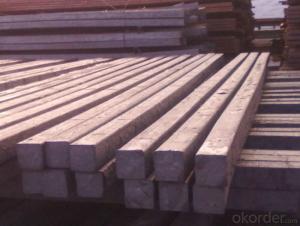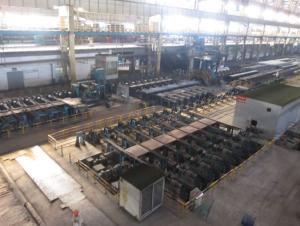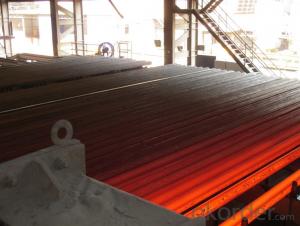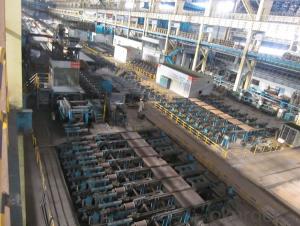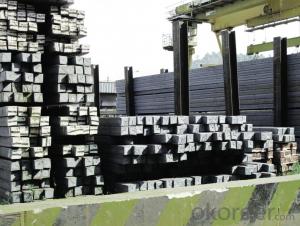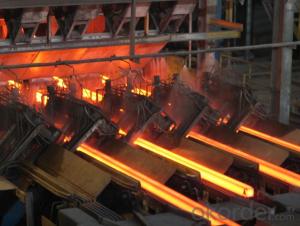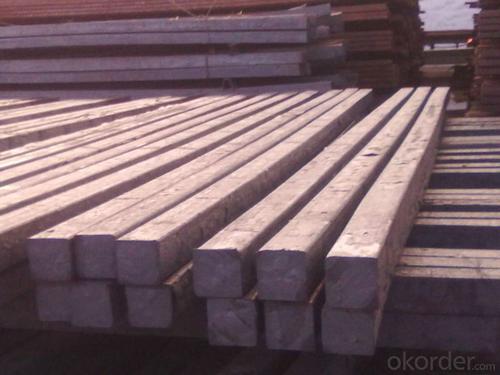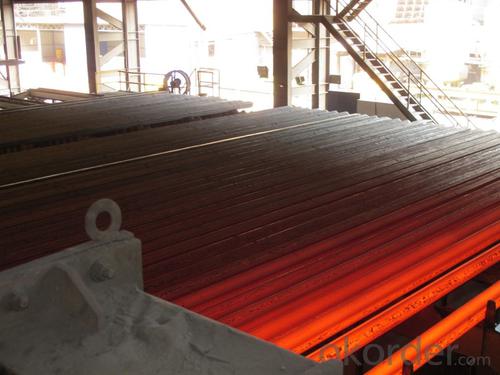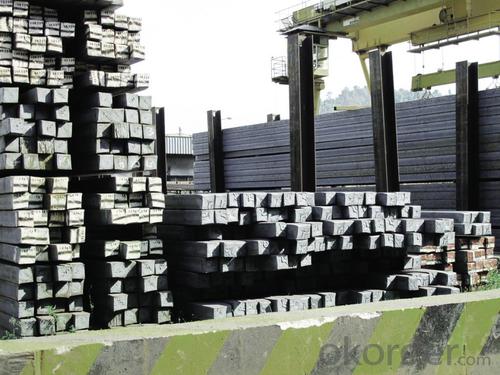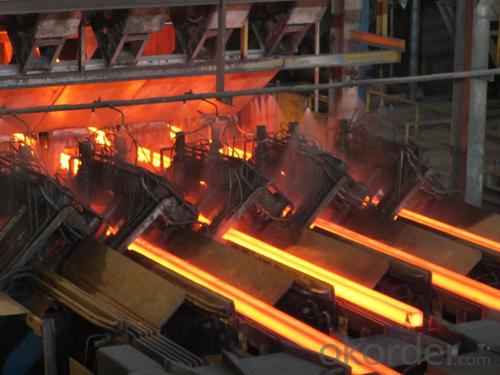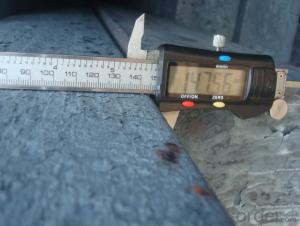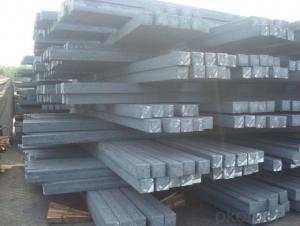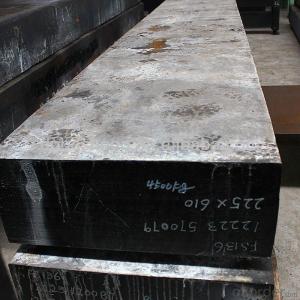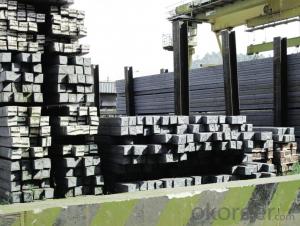Hot Rolled Steel Billet 3SP Standard 100mm
- Loading Port:
- Shanghai
- Payment Terms:
- TT OR LC
- Min Order Qty:
- 100 m.t.
- Supply Capability:
- 10000 m.t./month
OKorder Service Pledge
OKorder Financial Service
You Might Also Like
Structure of Hot Rolled Steel Billet 3SP Standard 100mm

Description of Hot Rolled Steel Billet 3SP Standard 100mm
Prepainted Rolled steel Coil is a kind of coated steel coil/sheet. With the cold rolled steel of different strength and thickness as substrate, it is produced through applying Al-Zn coat on both faces by hot dip process. In its coating, Al accounts for about 55%, Si 1.6%, while the remaining is Zn. Aluminum zinc coils enjoys both the physical protective feature and durability of Al and the electrochemical protective property of Zn. And its surface has bright silver color and regular embossed-like figure, which are highly decorative. RAL Scale Z35 Prepainted Rolled Steel Coil for Construction Roofing

Main Feature of Hot Rolled Steel Billet 3SP Standard 100mm
1.Corrosion resistance: It mainly depends on the zinc protection. When the zinc being worn,
2. Heat resistance: steel sheet has excellent heat resistance, can withstand high temperatures over 300 centigrade, and is similar with aluminized steel high temperature oxidation resistance. It often used in chimney pipes, ovens, fluorescent lighting device and the device cover.
3. Heat reflective: Galvanized steel plate heat-reflective high rate is twice as galvanized steel, often used to make insulation materials. RAL Scale Z35 Prepainted Rolled Steel Coil for Construction Roofing
Applications of Hot Rolled Steel Billet 3SP Standard 100mm
1. Construction and building: roofing; ventilating duct; handrail; partition panel;etc.
2. Electric appliance: refrigerator; washing machine; refrigerator; DVD;etc.
3.Transportation: oil tank; gas tank;road sign; etc.
4.Agriculture constructions :barn; etc.RAL Scale Z35 Prepainted Rolled Steel Coil for Construction Roofing
5.Others:vending machine; game machine; auto parts spare parts etc.
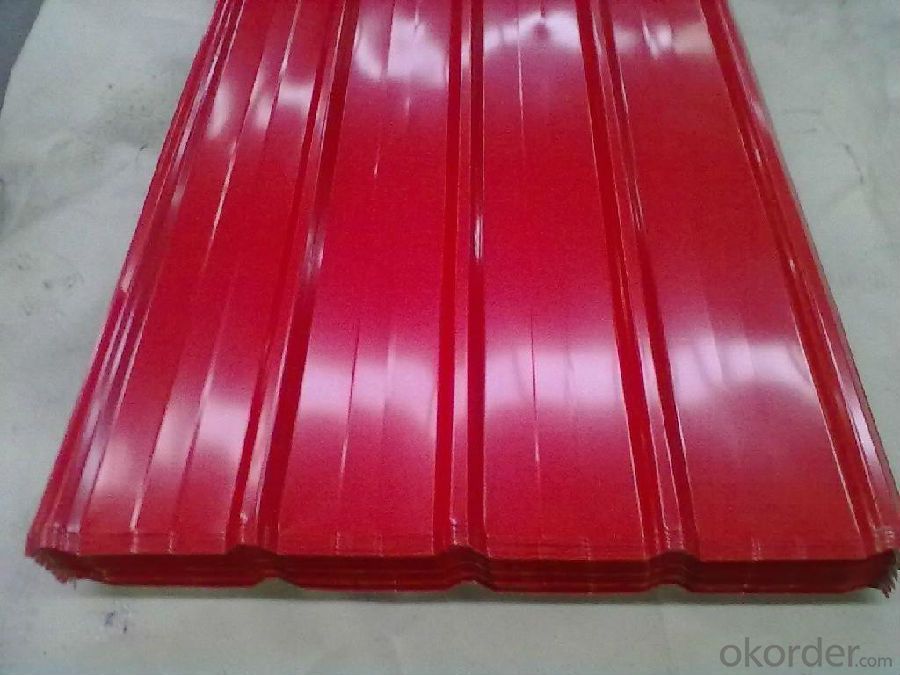
Specifications of Hot Rolled Steel Billet 3SP Standard 100mm
Product | Hot Rolled Steel Billet 3SP Standard 100mm |
Material Grade | SGCC / SGCH / DX51D+AZ, etc |
Thickness | 0.5-3.0mm |
Width | 700-1500mm |
Tolerance | Thickness: +/-0.02mm , Width:+/-2mm |
Zinc-coating | AZ30-150g/m2 |
Technique | Raw material: Hot rolled steel coil --> Cold rolled_>hot dipped galvalume |
Surface | Dried, Chromated, Unoiled,RAL Scale Z35 Prepainted Rolled Steel Coil for Construction Roofing |
Spangle | Regular spangle , small spangle, zero spangle |
ID | 508MM 610MM |
Coil weight | 25MT max |
Export package | Cardboard inner sleeves, Waterproof paper, galvanized steel covered and steel strip packed |
FAQ of Hot Rolled Steel Billet 3SP Standard 100mm
We have organized several common questions for our clients,may help you sincerely:
1. What is the minimum order quantity ?
Our MOQ is 100 mt for each size each specification. Usually we can offer discount if can buy large QTY once. RAL Scale Z35 Prepainted Rolled Steel Coil for Construction Roofing
2. How long can we receive the product after ordering?
Our general delivery time is 30 days after confirmation, but so some special orders, we have offer special delivery time
3. How to guarantee the quality of the products?
We have established the international advanced quality management system ,every link from raw material to final product we have strict quality test;We resolutely put an end to unqualified products flowing into the market. At the same time, we will provide necessary follow-up service assurance.
4. What is the payment?
We accept T/T, L/C
- Q: What are the main factors affecting the tensile strength of steel billets?
- The main factors affecting the tensile strength of steel billets include the chemical composition of the steel, the heat treatment process, the presence of impurities or defects in the material, the grain size and orientation, and the processing conditions used during manufacturing.
- Q: What are the different types of defects that can occur during casting of steel billets?
- There are several types of defects that can occur during the casting of steel billets. These include shrinkage cavities, porosity, cracks, inclusions, surface irregularities, and segregation. Shrinkage cavities occur due to the solidification process and can result in voids or cavities in the billet. Porosity refers to the presence of gas or air pockets within the billet, which can weaken its structure. Cracks can occur due to thermal stresses or improper cooling, leading to structural weaknesses. Inclusions are foreign materials such as oxides or non-metallic particles that can be trapped within the billet, impacting its quality. Surface irregularities refer to imperfections on the surface of the billet, which can affect its appearance and structural integrity. Segregation is the uneven distribution of alloying elements within the steel billet, leading to variations in the material's properties. These defects can impact the overall quality and performance of the finished steel product.
- Q: How are steel billets used in the manufacturing of construction machinery parts?
- Steel billets are crucial in the production of construction machinery parts. These semi-finished steel products serve as the raw material for shaping various machinery components. To initiate the manufacturing process, steel billets are heated to a high temperature in a furnace. This heating process enhances their malleability and facilitates further shaping. Once heated, the billets are passed through rollers and molds to achieve the desired shape and dimensions. Construction machinery parts such as gears, shafts, axles, and structural components require high strength and durability to withstand heavy-duty applications. Steel billets, made from high-quality steel alloys, possess these desirable properties, making them ideal for manufacturing such parts. After shaping, the billets undergo additional processes such as heat treatment and surface finishing. These treatments enhance their strength, hardness, and resistance to wear and corrosion. Consequently, the overall performance and longevity of the construction machinery parts are improved. The use of steel billets in the manufacturing of construction machinery parts offers several advantages. Firstly, steel is renowned for its excellent mechanical properties, including high tensile strength and toughness, which are vital for handling heavy loads and resisting impact and fatigue. Moreover, steel billets can be easily machined and welded, facilitating the precise manufacturing and assembly of complex machinery components. Additionally, steel is a versatile material that can be customized to meet specific requirements. By adjusting the composition and heat treatment processes, manufacturers can tailor the properties of the steel billets to suit the intended application of the construction machinery parts, ensuring optimum performance and durability. In conclusion, steel billets are indispensable in the production of construction machinery parts. Their high strength, durability, and versatility make them essential for manufacturing components that can withstand the demanding conditions of construction sites. By utilizing steel billets, manufacturers can create reliable and long-lasting machinery parts that contribute to the overall efficiency and safety of construction projects.
- Q: What are the main factors affecting the quality of steel billets?
- There are several main factors that can significantly affect the quality of steel billets. These factors include the composition of the steel, the temperature and time of the heating process, the cooling rate, and the presence of impurities. Firstly, the composition of the steel plays a crucial role in determining its quality. The presence of certain elements such as carbon, manganese, and silicon can affect the mechanical properties of the steel, including its strength and hardness. The proper control and balance of these alloying elements are essential to ensure the desired quality of the steel billets. Secondly, the temperature and time of the heating process during the production of steel billets are critical factors. The heating process must be carefully controlled to achieve the optimal temperature for the desired transformation of the microstructure. Overheating or underheating can lead to the formation of undesirable phases or an inconsistent microstructure, which can negatively impact the quality of the billets. The cooling rate is another important factor affecting the quality of steel billets. The cooling process needs to be controlled to achieve the desired microstructure and mechanical properties. Too rapid cooling can result in the formation of brittle phases or residual stresses, while slow cooling can lead to coarse-grained structures with reduced strength. Furthermore, the presence of impurities in the steel can significantly affect its quality. Impurities such as sulfur, phosphorus, and non-metallic inclusions can decrease the mechanical properties and promote the formation of defects in the steel billets. Therefore, strict control of the raw materials and the implementation of effective refining techniques are necessary to minimize the presence of impurities. In conclusion, the main factors affecting the quality of steel billets are the composition of the steel, the temperature and time of the heating process, the cooling rate, and the presence of impurities. By carefully controlling and optimizing these factors, steel manufacturers can produce high-quality billets that meet the desired specifications and performance requirements.
- Q: What are the different types of steel billet packaging?
- There are several types of steel billet packaging, including wooden crates, steel or plastic wrapping, and steel wire or strapping.
- Q: How do steel billets contribute to the shipbuilding industry?
- Steel billets are a crucial component in the shipbuilding industry as they play a significant role in the construction of ships. These semi-finished products are essentially molten steel that has been solidified into a specific shape, usually a square or rectangular block. They are typically obtained through the process of continuous casting or ingot casting. One of the primary ways in which steel billets contribute to the shipbuilding industry is by providing the raw material for the fabrication of various ship components. These billets are further processed through rolling, forging, or extrusion to create different structural elements, such as plates, beams, angles, and channels. These components are then used in the construction of the hull, decks, bulkheads, and other structural parts of the ship. Steel billets also possess several advantageous properties that make them ideal for shipbuilding. Their high strength and durability ensure the structural integrity and longevity of the ship, enabling it to withstand the harsh marine environment and constant exposure to seawater. Moreover, steel billets have excellent weldability, which allows for efficient and reliable joining of various components during the ship assembly process. Furthermore, the use of steel billets in shipbuilding offers a cost-effective solution. Steel is readily available and abundant, making it a cost-efficient material choice for the construction of ships. Additionally, steel is highly recyclable, allowing for the reuse of steel billets and reducing environmental impact. In summary, steel billets are vital to the shipbuilding industry as they provide the raw material for the fabrication of various ship components. Their high strength, durability, weldability, and cost-effectiveness make them an ideal choice for constructing ships that can withstand the demanding marine environment. Ultimately, steel billets contribute to the safe and reliable operation of ships, supporting the growth and development of the shipbuilding industry.
- Q: What are the common alloys used in the production of steel billets?
- The common alloys used in the production of steel billets are primarily carbon and manganese. Carbon is added to increase the hardness and strength of the steel, while manganese is added to improve the steel's toughness and hardenability. Additionally, other alloying elements such as silicon, nickel, chromium, and vanadium may be added in smaller amounts to further enhance specific properties of the steel, such as corrosion resistance, heat resistance, or wear resistance. These alloying elements help create a wide range of steel grades with varying characteristics that can be tailored to suit different applications and industries.
- Q: How are steel billets used in the production of automotive steering systems?
- Automotive steering systems rely heavily on steel billets, a crucial element in their manufacturing. These billets, typically crafted from high-quality steel, serve as the raw material for producing various steering system components like shafts, gears, and housings. The production process begins by heating and softening the steel billets to increase their malleability. This allows them to be easily molded and shaped into the desired steering system components through methods such as forging, rolling, or casting. The chosen technique depends on the complexity and function of the component being manufactured. Once the desired shape is achieved, the steel billets undergo further processing to enhance their strength and durability. This involves employing heat treatment techniques like quenching and tempering, which provide the steel with specific mechanical properties like improved hardness and toughness. These treatments ensure that the steering system components can handle the considerable loads and vibrations experienced during operation. After proper shaping and treatment, the billets undergo precision machining processes to attain the required dimensional accuracy and surface finish. This includes cutting, drilling, and grinding the billets to create the necessary profiles and features that enable optimal functioning within the steering system. Lastly, the finished steering system components are assembled together with other parts to create the complete automotive steering system. These components, manufactured from steel billets, play a critical role in transmitting driver input to the wheels, enabling precise control and maneuverability of the vehicle. In summary, steel billets are indispensable in the production of automotive steering systems as they provide the necessary strength, durability, and precision required for safe and efficient vehicle steering.
- Q: How are steel billets used in the manufacturing of construction machinery?
- Steel billets are used in the manufacturing of construction machinery as raw material for forging, casting, and machining processes. They are formed into various components such as gears, shafts, frames, and structural parts, providing the required strength and durability for heavy-duty applications in the construction industry.
- Q: What are the main factors affecting the surface quality of steel billets?
- Several factors influence the surface quality of steel billets. Firstly, the cleanliness of the steel is crucial. Impurities like oxides, scale, and inclusions can negatively impact the surface, causing defects such as pits, cracks, and roughness. Secondly, the temperature during the steelmaking process is important. Overheating can result in excessive scaling and oxidation, leading to a poor surface finish. Insufficient heating, on the other hand, can cause a non-uniform surface and inconsistent mechanical properties. Residual stresses also affect the surface quality. Uneven cooling or improper heat treatment can result in surface cracks, warping, or distortion. Surface treatment processes and their effectiveness also impact the surface quality. Grinding, polishing, or shot blasting can improve the surface finish by eliminating defects and creating a smoother surface. The quality of equipment and tools used in steel production plays a significant role as well. Worn-out or poorly maintained machinery can cause surface defects, inadequate surface preparation, or improper handling, thus affecting the final surface quality. Lastly, the composition and microstructure of the steel itself influence the surface quality. Variations in alloying elements, grain size, and phase distribution can affect the surface finish, hardness, and overall quality of the billets. In conclusion, cleanliness, temperature control, residual stresses, surface treatment processes, equipment quality, and steel composition are the main factors that affect the surface quality of steel billets. Proper steelmaking practices, surface treatments, and quality control measures are crucial in achieving high-quality steel billets with superior surface finish.
Send your message to us
Hot Rolled Steel Billet 3SP Standard 100mm
- Loading Port:
- Shanghai
- Payment Terms:
- TT OR LC
- Min Order Qty:
- 100 m.t.
- Supply Capability:
- 10000 m.t./month
OKorder Service Pledge
OKorder Financial Service
Similar products
Hot products
Hot Searches
Related keywords
